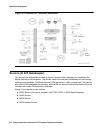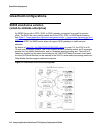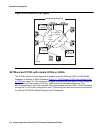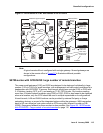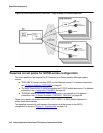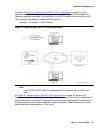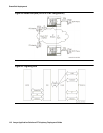
Components needed for Greenfield deployment
Issue 6 January 2008 111
Avaya Communication Manager
Communication Manager IP capabilities and applications support voice over an IP network, and
ensure that remote workers have access to communication system features from their PCs.
Communication Manager also provides standards-based control between servers and Media
Gateways, which allows the communications infrastructure to be distributed to the edge of the
network. The Communication Manager IP engine offers features that enable users to increase
the quality of voice communications. Quality of Service (QoS) features enable users to optimize
voice quality by assisting some routers in prioritizing audio traffic. Communication Manager
Media Processors allow for hairpinning and shuffling. These features make voice
communications more efficient by reducing both per-port costs and IP bandwidth usage. Avaya
IP Telephony Solutions support trunks, IP communications devices, IP Port Networks, and IP
control for Media Gateways.
Avaya IP Telephony Solutions are implemented using various IP Media Processor circuit packs
inside the Avaya Media Gateways. The IP Media Processors provide H.323 trunk connections,
and H.323 voice processing for IP Telephones. H.323 signaling is handled by a C-LAN circuit
pack or native processor Ethernet connectivity. The IP network can be extended across
geographically disparate locations. With Communication Manager ISDN, Distributed
Communication Services (DCS+), or QSIG services, Communication Manager can extend
feature transparency, centralized voice mail, centralized attendant service, call center
applications, and enhanced call routing across IP trunks.
For more information on Communication Manager architecture, see the Call processing
chapter.
Media Gateways and Port Networks
Avaya Media Gateways support voice and signaling traffic that is routed between
circuit-switched networks and packet-switched networks. Avaya Media Gateways support all
the applications and the adjuncts that are supported by the Avaya DEFINITY Enterprise
Communications Servers, accommodating Call Center and Customer Relationship
Management applications, messaging, remote workers, and remote offices. Avaya Media
Gateways work with standards-based IP networks, and connect easily with the Public Switched
Telephone Network (PSTN). The IP network infrastructure provides support for the
communication between the servers and the Media Gateways.
In a Greenfield installation, the recommended gateways are the G150, G250, G350, G650, and
the G700. The G650 houses traditional circuit switch boards and boards that support IP
Telephony. The G700, G350, and G250 house Avaya Media Modules that provide ports for
non-IP endpoints, including analog and DCP telephones. Use the G150 and the G250 gateways
for large scale, small-branch deployments (2-8 users each). Avaya recommends using the
G250 for high-intensity, critical applications, and using the G150 for more affordable solutions
where branches are more loosely coupled to headquarters.










